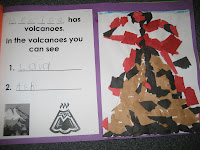Before doing anything in my classroom I take a minute to think – why am I doing this and what can be gained from it? Clear examples of this are the bulletin boards in my classroom. Bulletin boards should be meaningful and used for two purposes - to support student learning and to display student work. The majority of the displays in our classroom are used to enhance student learning. For example, our word wall and math tools board offer support to students during lessons and activities.
Word Wall: When students enter our classroom, the word wall is empty, aside from the headings and strips of Velcro. As we learn each others name and begin to read new words as introduced through our reading program, we add them to the wall to reference during reading and writing lessons. As I stated, I have placed a strip of Velcro under each letter. Each word is laminated and backed with a piece of Velcro, which makes for adding words to the wall a quick and easy task!
This is posted in our math center. Students reference the tools on this board throughout the day during all math related activities. Numbers and shapes are posted year round. As new skills are introduced, images, descriptions, and/or examples are added into the existing sleeves.
Student Work: In addition to being resources, our walls are covered in student work. Not only does this help students feel proud of their accomplishments, but it also allows parents and family members the opportunity to see what their child is doing in school.

To the left are examples of student work that can be seen on the walls of our classroom at some point during the school year. First is an activity we do at the beginning of the year to help learn the letters in our names. After reading Chicka Chicka Boom Boom. Each student has the opportunity to build their name on the Smartboard, which they will then transfer to a sentence strip. We finish the project by illustrating our own coconut tree and adding it to the Chicka Chicka Boom Boom bulletin board.

Second is our Look At Us bulletin board. Before coming to kindergarten, students draw a self-portrait of themselves and bring it to school with them on the first day to add to our board. At the end of each month, students make another self-portrait to add to our board. At the end of the year, I assemble the portraits into a book and students give them to their parents as a gift. Parents LOVE seeing how much their child has grown throughout the year!
























